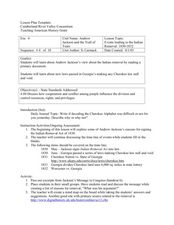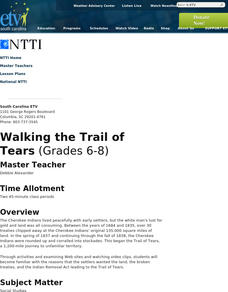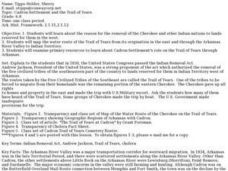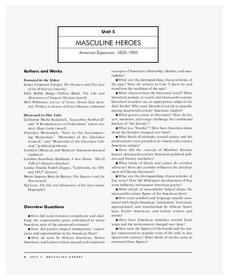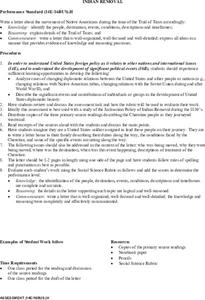K20 LEARN
Worcester v. Georgia: Cherokee Sovereignty and Actions of the U.S. Government
Young historians study the Supreme Court case "Worcester v. Georgia" and note instances where the Justices defended the sovereign rights of the Cherokee. They also examine the actions of President Andrew Jackson and the provisions of...
Curated OER
Jacksonian America and the Indian Removal Act of 1830
Students utilize primary sources to explore the national climate concerning Native American Indians during the Andrew Jackson administration. They are presented with opinions for and against the Indian Removial Act of 1830 as they...
K20 LEARN
Many Trails of Tears: The Era of Indian Removal
Cherokee, Chickasaw, Choctaw, Creek, and Seminole. All were forced off their ancestral lands in the southeastern United States as part of the Indian Removal Act of 1830. Young historians research the tribes' reactions to this removal and...
Curated OER
President Jackson, the Cherokee and Indian Removal
Students interpret historical evidence presented in primary and secondary resources. In this Indian Removal Act lesson, students examine the act and discuss the implications of moving the Cherokee. Students...
Curated OER
Events Leading to the Indian Removal 1830-1832
Students consider the effects of Indian Removal on the Cherokee Nation. In this American history lesson, students research Internet and print sources regarding the Indian Removal Act of 1830. Students write short stories that detail the...
Curated OER
Indian Removal: The Cherokees, Jackson, and the “Trail of Tears”
Students examine executive power. In this Indian Removal lesson, students listen to their instructor present a lecture regarding the "Trail of Tears". Students respond to discussion questions regarding the lecture.
Smithsonian Institution
Eastern Indian Wars
Many know that Native Americans were forced off their lands and moved west, but how did these people react? The Red Sticks faction of the Creek nation opted to defend themselves and their lands in a series of wars called the Eastern...
Curated OER
Trail of Tears
A fabulous PowerPoint resource that thoroughly and accurately desicribes the Cherokee culture from the 1500's through the mid-1800's when they were forced to leave their homeland and march to Oklahoma in the famous, "Trail of Tears."...
Curated OER
Lesson Plan: The Math of Removal
Students consider the plight of those who walked the Trial of Tears. In this Indian Removal lesson, students compare statistics regarding Indian survival rates.
Alabama Department of Archives and History
Conflict in Alabama in the 1830s: Native Americans, Settlers, and Government
To better understand the Indian Removal Act of 1830, class members examine primary source documents including letters written by Alabama governors and the Cherokee chiefs. The lesson is part of a unit on the expansion of the United...
Curated OER
Removal of the Cherokees in Relation to Westward Expansion
Students explore the concept of Manifest Destiny. In this Westward Expansion lesson,students examine primary and secondary, print and nonprint sources regarding the removal of the Cherokee.
Curated OER
Walking the Trail of Tears
Middle schoolers, through the use of examining video clips and Websites, become familiar with the reasons that the settlers wanted the land, broke treaties, and initiated the Indian Removal Act leading to the Trail of Tears.
Curated OER
Cadron Settlement and the Trail of Tears
Young scholars examine the reason for removal of the Cherokee and other Indian nations. They map the water route of the Trail of Tears from its origination in the east and through the Arkansas River Valley to Indian Territory.
Curated OER
Third Grade Social Studies- Quiz
In this social studies learning exercise, students complete a 25 question multiple choice quiz about early American colonial life and the Cherokee and other Native American tribes.
Curated OER
Trail of Tears
Students discover that the Indian Territory was comprised of many Indian tribes originating from many different locations. They distinguish between the Indian tribes in the Indian Territory.
Curated OER
How the West was Lost-The Trail of Tears
In this Native American history worksheet, students respond to 14 short answer questions about Cherokee removal polices and the Trail of Tears.
Curated OER
Trail of Tears
In this researching and recording worksheet, students research facts about the Indian Removal Act of 1830 and write short illustrated paragraphs answering the comprehensive questions. Students answer 4 questions.
Curated OER
The Cherokee Removal
Eleventh graders examine the issue of Cherokee removal from the perspectives of Andrew Jackson, members of Congress, and members of the Cherokee nation. They adopt the perspectives and engage in debate over the issue of Cherokee removal.
Annenberg Foundation
Masculine Heroes
What were the driving forces behind American expansion in the nineteenth century, and what were its effects? Scholars watch a video, read biographies, engage in discussion, write journals and poetry, draw, and create a multimedia...
Race Briges Studio
I am Indopino: Or, How to Answer the Question, "Who Are You?"
In our increasingly multi-ethnic society, many learners find it difficult to identify themselves as belonging to any one ethnicity. Gene Tagaban, a Tlingit, Cherokee, Filipino offers his personal experiences with these questions in his...
Curated OER
Yours and My Trail of Tears
Students investigate the Trail of Tears. In this United States history instructional activity, students identify the reason for removing the Cherokee Nation and role play a modern day situation similar to the Indian Removal Act. Students...
Curated OER
Indian Removal
Students investigate the historical events surrounding The Trail of Tears. They write a letter that identifies the people, destination, events, and descriptions surrounding the timeframe. Students provide a written summary of the history...
Curated OER
The Trail of Tears; Its Grief and Loss
Fifth graders trace the development and expansion of the US while studying the Trail of Tears. They examine the political factors and analyze the impact the Indian Removal Act had upon a society. They present a case for or against the...
Museum of Tolerance
The Pursuit of Democracy and Diversity: The Trial of Pro-Social Injustice in Historical Documents and Accounts
Class members investigate The Indian Removal Act of 1830, U.S. Theft of Mexican Territory Timeline, and President Abraham Lincoln’s letter to Horace Greeley, 1862, and then conduct a mock trial of each of these documents to determine...






